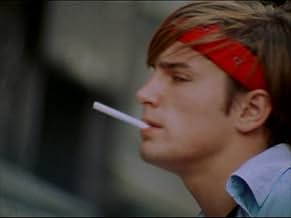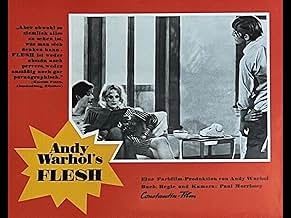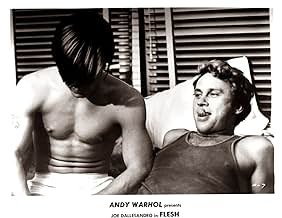VALUTAZIONE IMDb
5,7/10
2706
LA TUA VALUTAZIONE
Un uomo alla disperata ricerca di soldi e senza reddito, si prostituisce e interagisce con una varietà di clienti e imbroglioni.Un uomo alla disperata ricerca di soldi e senza reddito, si prostituisce e interagisce con una varietà di clienti e imbroglioni.Un uomo alla disperata ricerca di soldi e senza reddito, si prostituisce e interagisce con una varietà di clienti e imbroglioni.
- Premi
- 1 vittoria in totale
Roberto D'Allesandro
- Boy in the Street #2
- (non citato nei titoli originali)
Jed Johnson
- Solicitor
- (non citato nei titoli originali)
Recensioni in evidenza
It seems inhumane to describe someone as a work of art but in the Warhol
Art Sphere there seems little other way to describe Joe Dallesandro in
"Flesh". His body is displayed constantly in the nude, more consistently
naked than any other actor I can think of in American film history.
Warhol/Morrissey (the authorship of the movie remains contentious though
Morrisey is the credited director, the film rides under the "Andy
Warhol's" banner) objectify and expose every part of Dallesandro's
hustler in the film. He was truly the first sex symbol of the 70s. It
was only in "Flesh" he was so un-self-conscious and innocent though
always with survivalist and self-serving cunning. Joe (the character) is
an interesting kafka-esque (unable to control the world around oneself,
prone to the ebb and flow of circumstance and external control) figure
in the midst of a collage of underground culture figures of the 60s from
drag artistes to quivering tricks. Its a high camp affair at times but
Morrissey has a loving camera when it comes to Joe. Joe's beauty is
vividly captured and the fly-on-the-wall style story of a day in his
life remains engaging a
Art Sphere there seems little other way to describe Joe Dallesandro in
"Flesh". His body is displayed constantly in the nude, more consistently
naked than any other actor I can think of in American film history.
Warhol/Morrissey (the authorship of the movie remains contentious though
Morrisey is the credited director, the film rides under the "Andy
Warhol's" banner) objectify and expose every part of Dallesandro's
hustler in the film. He was truly the first sex symbol of the 70s. It
was only in "Flesh" he was so un-self-conscious and innocent though
always with survivalist and self-serving cunning. Joe (the character) is
an interesting kafka-esque (unable to control the world around oneself,
prone to the ebb and flow of circumstance and external control) figure
in the midst of a collage of underground culture figures of the 60s from
drag artistes to quivering tricks. Its a high camp affair at times but
Morrissey has a loving camera when it comes to Joe. Joe's beauty is
vividly captured and the fly-on-the-wall style story of a day in his
life remains engaging a
I guess only a selected number of audience members really had any interest in watching how a male hustler in New York operates but I'd be willing to bet that even these brave souls were turned off by the irritating patchwork technique and deliberately muffled sound recording on display here; the fact that these inherent 'defects' were a direct result of the film's low-budget/underground/experimental nature is, I'd say, beside the point. Anyway, for those so inclined, the film features extensive male nudity and Joe Dallesandro, understandably, became an underground and gay icon!
The episodic structure showing the day-to-day routine of the hustler protagonist offers a couple of mildly interesting scenes: his meeting with (and eventually posing for) an eccentric elderly artist; the one where Dallesandro expresses his views on his unusual line of work and delineates his particular modus operandi to a couple of prospective 'colleagues' including perhaps the unlikeliest of hustlers a bespectacled nerd! Perhaps mercifully, the film ran for only 89 minutes against the IMDb's claim that its complete length is 105 (but the latter could well be a mistake)!
I had watched a few other of Warhol's 'movies' and this one is decidedly not as satisfying as the most tolerable example I've run into yet, BAD (1977), and only slightly better than the likes of MY HUSTLER (1965) which were mostly a strain to sit through. The fact that this was only the first part of a trilogy did not augur well but, as the saying goes, you gotta to do what you gotta do and the other two 'chapters' had to follow in quick succession...
Despite my generally negative reaction to it, FLESH is nevertheless still valuable as a 1960s time capsule and as a prototype of the Underground scene of that era, both cinematically and in real life. For the record, an image of Dallesandro from this film adorns the sleeve of The Smiths' self-titled 1984 debut album and transsexual Candy Darling (who appears here rather unremarkably) was immortalized in "Candy Says", the opening track of The Velvet Underground's eponymous 1969 album. Although the latter band is my all-time favorite, and one of the reasons for this is that, through their sheerly unique and ground-breaking music, they described a lifestyle so utterly different from my own, this is truly a case where I'd much rather experience something aurally instead of visually!
The episodic structure showing the day-to-day routine of the hustler protagonist offers a couple of mildly interesting scenes: his meeting with (and eventually posing for) an eccentric elderly artist; the one where Dallesandro expresses his views on his unusual line of work and delineates his particular modus operandi to a couple of prospective 'colleagues' including perhaps the unlikeliest of hustlers a bespectacled nerd! Perhaps mercifully, the film ran for only 89 minutes against the IMDb's claim that its complete length is 105 (but the latter could well be a mistake)!
I had watched a few other of Warhol's 'movies' and this one is decidedly not as satisfying as the most tolerable example I've run into yet, BAD (1977), and only slightly better than the likes of MY HUSTLER (1965) which were mostly a strain to sit through. The fact that this was only the first part of a trilogy did not augur well but, as the saying goes, you gotta to do what you gotta do and the other two 'chapters' had to follow in quick succession...
Despite my generally negative reaction to it, FLESH is nevertheless still valuable as a 1960s time capsule and as a prototype of the Underground scene of that era, both cinematically and in real life. For the record, an image of Dallesandro from this film adorns the sleeve of The Smiths' self-titled 1984 debut album and transsexual Candy Darling (who appears here rather unremarkably) was immortalized in "Candy Says", the opening track of The Velvet Underground's eponymous 1969 album. Although the latter band is my all-time favorite, and one of the reasons for this is that, through their sheerly unique and ground-breaking music, they described a lifestyle so utterly different from my own, this is truly a case where I'd much rather experience something aurally instead of visually!
In a lot of ways this film defines the essence of everything I love about cinema, in terms of capturing those strange, elusive moments of unguarded truth. In other ways, it is undeniably an amateurish, unfocused result of junkies self-indulgently fooling around with a camera. Ultimately it comes out somewhere between pure brilliance and unwatchability (thankfully much more so the former than the latter). Part of me wants to reward it solely for it's absolute innovativeness and moments of pure sublimity, but at the same time I can't completely ignore the occasionally downright awful "acting" and overtly bad production values. At first the editing seems overwhelmingly sloppy and needlessly distracting (or maybe just wrongheadedly "innovative"), but after a while I got used to it, which is, in the end, the true sign of whether a film succeeds on it's own terms or not. I guess that answer basically sums up my all-around feelings for the film. That is, despite it's in-ignorable flaws, on a whole it does work very well. And, if nothing else, a film like this really shows how false and contrived the faux-documentary, shaky-cam style can sometimes be when it so obviously applied purely for effect (such as in films like the otherwise admirable Roger Dodger). Here the aesthetics are plainly derived from the necessities of the filming situation, and are not just used arbitrarily to make it look "cool".
Because this flick is the first feature fruit of a long lasting collaboration between Paul Morrissey, Andy Warhol and Joe Dallessandro, it is too much obvious that it was mostly made for having fun among themselves. The script is quite loose, the dialogues are too obviously improvised, one even suspects that there probably is no script at all, just thematic concepts: prostitution, addiction and poverty (which all seem to continue in the following films Trash and Heat).
Joe Dallessandro reveals unashamedly his gorgeous body at any chance, to the hungry eyes of other addicts (not only drug addicts).
Although the whole film seems like amateurish, especially the scene with other hustlers at the park is very intriguing, like a documentary project.
I would not recommend to see this by itself, but watching the trilogy (Flesh, Heat and Trash) altogether will be much enlightening.
Joe Dallessandro reveals unashamedly his gorgeous body at any chance, to the hungry eyes of other addicts (not only drug addicts).
Although the whole film seems like amateurish, especially the scene with other hustlers at the park is very intriguing, like a documentary project.
I would not recommend to see this by itself, but watching the trilogy (Flesh, Heat and Trash) altogether will be much enlightening.
The opening static shot of Joe sleeping, for a full 4 minuets was very reminiscent of Earlier work done by Morrissey's Quasi-partner, Warhol on the movie Sleep, which is a static shot of some guy sleeping for 6 hours. But Unlike Warhol's work, Paul Morrissey put the narrative into the Warhol aesthetic principals,by giving the actors more substance to each scene, and then moving around the camera, and following the actors actions more closely with a omnipresent eye that doesn't inhibit the actors in sometimes highly improvised situations. (unlike in Warhol's work actors/actresses were aware of the camera at all times and didn't allow them to lose themselves in the moment on screen).Yes there is allot of Improvisation in this film which is what gives it the feeling of watching something that is real. The movie was not scripted, before every scene Paul Morrissey told each actor what he wanted from each scene and the actors were left to their own devices improvising dialogue and advancing the narrative. Choosing the subject of Hustling for a living, selling your self for money, and pairing it with an actor that knows about the lifestyle is what really gave Joe the opportunity to make the character believable. In fact after the movie was shown around the world, people actually thought Joe was Like that in real life, Just like in TRASH, everyone really thought Joe was a junkie. One good scene has Joe picked up by an older gentleman who wants Joe only to pose for some artwork. Joe tells him he wants to earn 100 bucks, (to pay for his wife's girlfriend's abortion) "one hundred dollars!, you'll have to take off all your clothes for that" the old man tells him. The old man is in fact hiding his homosexuality, Pretending to be an artist. Back at his place He tells Joe to take off his clothes, saying that that is the hardest part for anyone to do when posing for art. But Joe's not shy, He takes off all his clothing and starts posing in various olympiadic poses,. While the old man rants on about the different artworks in contemporary society, the aesthetic of greek statues, philosophizing on the beauty of human skin, and how people are obsessed with it, It's too much for Joe, Joe interrupts him asking him for the dinner he promised him. The aesthete's rationalization is paralleled by Joe's last customer of the day, Louis Waldon playing a guy Joe knows from the gym. He pretends that their sex is for the friendlier motive than the money Joe always requests and that despite their sex, "we're not queers." The pretense to friendship is undermined when the customer shifts from the passive suggestions to brusquely ordering Joe about. The client's delusions show his need for purity in a relationship-such as glimpsed in Joe's scene with the baby, where he is nude on the floor feeding the baby bits of muffin. Only with the baby is Joe shown in a relationship were he is not a commodity. Joe runs into some other hustlers on the street, younger ones who sorta look at Joe with respect, because he's the more experienced Hustler, and they being ones who want to learn more. One of the boys asks him if he's straight Joe say's "Hey nobody's straight. What's straight? It's not a thing of being straight or being not straight. It's just...you just do whatever you have to do", and about the johns, he only says "they only wanna suck your peetta!" In another memorable scene With Geri Miller, Candy Darling, Jackie Curtis, and Joe. Morrissey pans from, Candy and Jackie (transvestites in real life) sitting down on a couch reading from an old Hollywood magazine > The trannie's quote stuff from the magazine and then Geri's goes into her dramatic story of her rape, meanwhile Joe (emotionless) listens to it all. Later Geri does a topless dance at Joe's request but he ignores her. The film ends like it begins, but with a difference.Again Joe is Naked on his belly on the bed. Reversing the opening order, the full-length view is followed by the profile close-up. But now Joe is no longer alone. His wife is asleep beside him, but between them lies her new lover, the women's legs ardently intertwined. We see him in the relationship from which he is excluded. Joe's naked solitude is redefined as an alienation within a relationship. The film went on to gross over $2,000,000 dollars, making it a very profitable, considering it was done on a budget of only $1,500. It was banned from England for a while, and in Germany 3,000,000 people saw it making it one of the top movies in Germany in that year. It was the first underground film that was accepted on a wide scale basis, and made Joe a very well known person all over the world.
Lo sapevi?
- QuizUK censor John Trevelyan was wary of issuing the film a cinema certificate and suggested to the distributors that the film be shown on a club basis. When it was initially shown at the Open Space Theatre in London in February 1970 the cinema was raided by police who attempted to seize the film, leading Trevelyan himself to hastily rush to the cinema and vigorously defend the movie against possible prosecution, calling the police action 'unjustified and preposterous'. In the light of this incident Trevelyan was able to grant the film an uncut 'X' certificate.
- BlooperDuring a scene with the go-go dancer, Candy and Jackie alternately call her by the character's first name (Terry) and that of the actress playing her (Geri Miller).
- Citazioni
Joe, the Hustler: How am I supposed to make any money without clean underwear?
- Curiosità sui creditiThe opening credits run sideways and list Warhol's name, the title, the main cast members, and that it was written, photographed and directed by Paul Morissey.
- ConnessioniEdited into Porno e libertà (2016)
- Colonne sonoreMakin' Wicky Wacky Down in Waikiki
Performed by Sophie Tucker.
I più visti
Accedi per valutare e creare un elenco di titoli salvati per ottenere consigli personalizzati
- How long is Flesh?Powered by Alexa
Dettagli
- Data di uscita
- Paese di origine
- Lingua
- Celebre anche come
- Andy Warhol's Flesh
- Luoghi delle riprese
- Greenwich Village, New York, New York, Stati Uniti(At the apartment of critic David Bourdon)
- Azienda produttrice
- Vedi altri crediti dell’azienda su IMDbPro
Botteghino
- Budget
- 4000 USD (previsto)
- Tempo di esecuzione1 ora 29 minuti
- Mix di suoni
- Proporzioni
- 1.37 : 1
Contribuisci a questa pagina
Suggerisci una modifica o aggiungi i contenuti mancanti



























